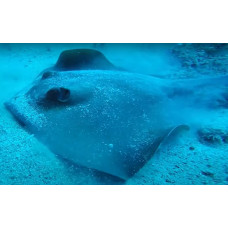Latin name
Dasyatis pastinaca
Other names
Dasyatis pastinaca
Identification
The pectoral fins merge with the head to form a diamond-shaped flat disc, only slightly wider than long, with rounded fins ("wings"). The front edge of the disc is almost straight, and the snout is slightly pointed, projecting slightly beyond the disc. The skin is generally smooth, but there are a few small bony patches and blunt barbs on the back. The long and flexible bicoid tail is equal in length to the disc in adults, and about one and a half times as long as the body in juveniles. Like other Dasyatidae, has a serrated spike or needle on the tail, connected by ducts to a venom gland. Sometimes stingrays have 2 or even 3 spines as the spike periodically breaks off and a new one grows in its place. Behind the spine, the tail stalk is covered by shallow upper and deep lower skin folds. The thin and long tail has upper and lower fin folds. The dorsal surface is evenly coloured and the smooth skin is free of scales. Large individuals may have a series of tubercles along the midline of the disc. Capable of inflicting painful stings with the venomous sting, which are not usually life-threatening. The sting is located in the centre of the tail and can reach 35 cm in length in large individuals. The body colour is contrasting - the back is dark, brownish, grey or dirty olive, often densely covered with small, striped or ring-shaped patches forming a pattern; the patches are usually of the same tone as the main ground colour, but more saturated and not strongly defined. The abdomen is pale, off-white, without pattern. On the ventral surface of the disc there are 5 gill slits, a mouth and nostrils. Behind the eyes the gill cavity opens with very wide spathe, which are much larger than the eyes and close together. The mouth has 28-38 upper teeth and 28-43 lower teeth. The teeth are small and blunt. The floor of the mouth is covered with tubercles.
Distribution
The distribution is concentrated along the entire European coastline from the western Baltic Sea southwards to the Strait of Gibraltar and further along the coast of Africa to Senegal. Includes the entire Mediterranean (more common in the western Mediterranean). Also found in the Sea of Marmara, the Black Sea and the Sea of Azov. In the Atlantic it is common near the Canary Islands and the Azores. It is one of the few rays found in Russian waters and the only tailfin ray found in Ukrainian waters (Black Sea and Sea of Azov).
Habitat
Despite its wide distribution and occurrence in well-studied areas, the lifestyle of this stingray is poorly understood. Occurs as far north as 61° but tends to be found in subtropical waters. Mainly coastal, often entering estuaries and appearing near coastal cliffs. It prefers shallow waters with sandy or muddy bottoms, usually no deeper than 60 metres, although it has been recorded at 200 metres. It spends much of its time half buried in the sand or mud. It is usually solitary, only occasionally forming small aggregations.
Size
The usual length is about 1 m including the tail, the average weight of an adult is 6-10 kg, but sometimes fish up to 2.5 m long and weighing up to 20 kg are found, which allows us to classify them as large representatives of the super-order of stingrays. The maximum recorded width of the disc is 1.4 m. Females are slightly larger than males. Life expectancy is up to 20 years.
Life history and Behavior
Reproduction by oviparity. Embryos develop in the womb, feeding on egg yolk and histotroph. There are 4-9 newborns in a litter.
Food and feeding habits
They eat small bottom-dwelling animals such as crustaceans, molluscs and polychaetes, and sometimes larger fish. The shells of crustaceans and molluscs are chewed with powerful teeth fused into a single plate.
Reproduction
Egg-laying fish. Fertilisation is internal. The development of the embryos takes about a year and takes place in special extensions of the oviducts. In the late stages of development, the embryos feed on secretions from the uterine wall. In the summer, females give birth to 4 to 5-6, up to 12 young (up to 3 cm long). As soon as the calf leaves the mother's body, it turns and swims away.
| Classification | |
| Phylum | Chordata |
| Class | Chondrichthyes |
| Squad | Myliobatiformes |
| Family | Dasyatidae |
| Genus | Dasyatis |
| Species | D. pastinaca |
| Features | |
| Conservation status | Vulnerable |
| Habitat | Bottom |
| Life span, years | 20 |
| Maximum body weight, kg | 20 |
| Maximum length, cm | 140 |
| Sailing speed, m/s | No information |
| Threat to people | Inedible |
| Way of eating | Non-predatory |
Common stingray
Tags: common stingray


